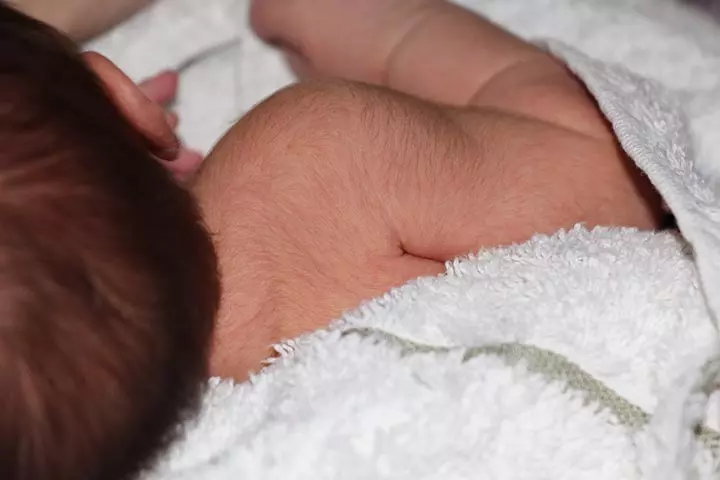
Image: iStock
Welcoming one’s child into this world is a special feeling for the parents. During the pregnancy months, parents try their best at learning about parenting and what they can expect in the coming months. They immerse themselves in books, blogs, videos, and consultations with doctors and experts. But it doesn’t matter how much you’ve prepared for the arrival of your baby, You may still end up witnessing bizarre things. Often, when parents see something out of the ordinary concerning their little ones, they tend to freak out. You too may notice a few things with your newborn that take you by surprise. But we’re here to tell you that some of the strange things you see are actually pretty normal.
From baby heads that are weirdly shaped to the lack of tears when they cry, babies can be a little strange! Read on for a bunch of strange but normal things to expect with your bundle of joy:
1. The Shape Of Your Baby’s Head May Be Conical

Image: Shutterstock
The skull bones in a newborn baby’s head are not fused together. This is to facilitate better movement through the birthing process. Your baby has to make their way through the birthing canal, and during a normal delivery, babies make their way out head-first. When this happens, a lot of pressure is put on their heads as they make their way through a small space (of your nether regions). During this process, your baby’s head may get molded into a mildly conical shape. Although it may concern you and look strange, you can rest assured that the shape of your baby’s head will get back to normal in a matter of a week or two (1).
2. They’re Always Crying…Or Are They?

Image: IStock
We know for a fact that babies cry a lot. In fact, it may seem like that’s all they do. However, if you see your baby cry, but you don’t see any tears at all, don’t be alarmed. When babies are born, they tend to be a little dehydrated. Whatever intake of water that is required was received in the womb. Babies have incredibly tiny tummies, which makes them incapable of holding large amounts of water. All the hydration that they need, they receive from breast milk or baby formula. In case you didn’t know, doctors don’t even recommend water until they’ve turned six months of age!
So, given the little amount of water they have (just enough to hydrate them), their bodies tend to take some time to make tears. Your baby should essentially be able to cry (with the waterworks) after about two weeks or by the end of their first month. Watch out for Dacryostenosis, a condition in which newborns suffer from a tear duct that is blocked. You may notice a discharge that is crusty in the corner of your child’s eye in such cases. Talk to their pediatrician when you notice anything unusual such as a discharge from their eyes (2).
3. Babies Don’t Have Teeth When Born, Do They?

Image: Shutterstock
Some of them do! Unlike regular teeth, natal teeth are what you see when a baby is born. Most babies are not born with natal teeth but don’t freak out if you see yours with a tooth or two when they arrive. Natal teeth are usually discolored and soft, and they aren’t attached firmly to their gums. They’re generally shaky and tend to fall after a few months. Keep an eye on your baby when their natal teeth get really loose, as they can turn out to be a choking hazard. When they begin to get loose, it is best to get your child consulted by a pediatric dentist so they can get it removed safely (3).
4. Hair All Along Their Backs!

Image: Shutterstock
We often come across babies that barely have any hair on their heads. Some of them don’t even have eyebrows or eyelashes! And then some babies look like tiny bears! It’s normal for some babies to have hair along their neck, shoulders, and backs. It even has a term — lanugo. Babies develop all that hair in the womb, and it serves as protection for their skin. It also helps regulate their body temperature. All that hair tends to shed in a few weeks. If your baby had a premature birth, they tend to take longer to shed their excess hair, but it happens all the same. So, don’t worry about it (4).
5. Something Wrong With Their Poop?

Image: IStock
A lot of parents get scared when they change their baby’s diapers for the first few days. This is because their poop looks nothing like poop! You may notice something that looks like tar instead. What you’re seeing is meconium. It is essentially waste that is eliminated from their body, and it contains fats, proteins, toxins, and cells. Their poop will slowly turn into normal in a few days once they start drinking breast milk or baby formula (5).

Image: Shutterstock
After babies are born, the umbilical cord is cut off as its purpose of feeding the baby inside the womb has been served. But a tiny protrusion stays behind in the baby’s navel area for some time. It takes a few weeks before the navel area starts looking the way we know it to be. The stem dries and falls off automatically, and is totally normal. Also, parents might be worried about the size of the umbilical stem. But it’s nothing to be worried about as the size of this stem can vary from baby to baby. Only if you notice some infection or the stem doesn’t dry off for more than three weeks, consult your doctor (6). It is quite harmless, but make sure it does not retain moisture for a long time. Keeping it dry is important or it will lead to infection.
Babies are weird in the first few weeks of their life, and if you’ve observed the above, we hope that you don’t worry as much since you know it’s all normal. However, if you find something unusual and see that it requires medical intervention, do so at the earliest. What are some of the strange things you observed in your baby? Let us know in the comments below!
References
- Misshapen Heads in Babies: Position or Pathology?
https://www.ncbi.nlm.nih.gov/pmc/articles/PMC3116745/ - “Crying without tears” as an early diagnostic sign-post of triple A (Allgrove) syndrome: two case reports
https://www.ncbi.nlm.nih.gov/pmc/articles/PMC5769402/ - Natal and Neonatal Teeth: An Overview of the Literature
https://www.ncbi.nlm.nih.gov/pmc/articles/PMC3759256/ - Hormone levels in neonatal hair reflect prior maternal stress exposure during pregnancy
https://www.ncbi.nlm.nih.gov/pmc/articles/PMC4788554/ - Meconium
https://www.ncbi.nlm.nih.gov/books/NBK542240/ - Umbilical granuloma: a new approach to an old problem
https://pubmed.ncbi.nlm.nih.gov/11666047/
Community Experiences
Join the conversation and become a part of our nurturing community! Share your stories, experiences, and insights to connect with fellow parents.












